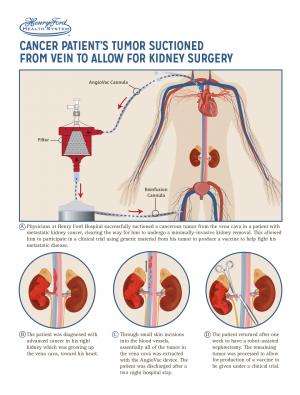First-in man: Tumor suctioned from vein to allow minimally invasive kidney surgery

Physicians at Henry Ford Hospital successfully suctioned a cancerous tumor from a major vein in a patient with metastatic kidney cancer, clearing the way for him to undergo a minimally-invasive kidney removal. This allowed him to participate in a clinical trial using genetic material from his tumor to produce a vaccine to help fight his metastatic disease.
It was the first time such use was made of the AngioVac, a device which employs large suction catheters to filter blood through a cardiac bypass machine and remove clots, tumors or other foreign material.
"This is a very exciting new way to treat these tumors," says Craig Rogers, M.D., the Henry Ford urologist and surgeon who led the multidisciplinary team in this endeavor.
"Of the 50,000 to 60,000 new cases of kidney cancer diagnosed each year in the United States alone, about a third will be metastatic - advanced beyond the kidney."
"Until now, these patients with complex tumors involving the major vessels have not had a lot of options. The AngioVac procedure offers one."
Chris Teodoro, 60, of Madison Heights, Mich., was admitted to Henry Ford Hospital through the emergency room after complaining of pain and blood in his urine. He was diagnosed with a very advanced cancer after scans showed a tumor in his right kidney was growing into a major blood vessel, the vena cava, toward his heart.
At first, Dr. Rogers believed Mr. Teodoro was not a good surgical candidate because of the extent the tumor had spread into his vena cava and his lungs. He would need a complex surgery to remove the cancerous kidney and the diseased portion of the vena cava, then "clean out" the large vein and reconstruct it back together.
"We thought the risks outweighed any benefits he may receive," Dr. Rogers says.
Aware of the AngioVac and its use in cardiovascular surgery, Dr. Rogers consulted with another Henry Ford physician about a novel approach.
"When Dr. Rogers approached me about possibly using the AngioVac procedure to help this patient, I was intrigued and excited about using this new technology," says Scott Schwartz, M.D., the interventional radiologist who uses the device. "I knew that we had to find a way to make this work in an attempt to give this patient hope for any future surgical treatment."
Then, when a new clinical trial was begun at Henry Ford with Dr. Rogers as its principal investigator, he reconsidered Mr. Teodoro's options.
The clinical trial, also being undertaken by other medical centers around the world, focuses on the use of genetic material - RNA - taken from a patient's own cancerous kidney tumor to create a vaccine to help fight the disease.
The biggest obstacle to Mr. Teodoro's admission into the clinical trial was the clock. To be eligible, his cancerous kidney had to be removed and its tumor processed for genetic material within 30 minutes.
Although Dr. Rogers had removed hundreds of diseased kidneys quickly using minimally invasive robot-assisted techniques pioneered at Henry Ford Hospital, the time required for extraction and reconstruction of the diseased vena cava ruled out a minimally invasive approach. A large open incision to remove the entire tumor was considered too invasive, leading to a prolonged recovery that could have made him ineligible to receive further treatments.
Dr. Rogers decided after consulting with Dr. Schwartz and other specialists, the AngioVac might be used to vacuum or suction the tumor out of the vena cava without surgically removing it. Then, using now-routine minimally invasive robot-assisted techniques, the diseased kidney could be removed and handed off to a pathologist for genetic processing - all within the 30-minute limit.
"That was when this multidisciplinary endeavor, first in the world done here at Henry Ford Hospital, was thought to be a good option for this patient," Dr. Rogers says.
These joint procedures were successful, and together, the first of its kind.
"The AngioVac procedure entails making small incisions into the major blood vessels through the skin." Dr. Schwartz and Loay Kabbani, M.D., a vascular surgeon, have pioneered its use at Henry Ford Hospital for other indications.
"Essentially the entire tumor in the vena cava was removed through these tiny incisions," Dr. Schwartz says. "After a two-night hospital stay, Mr. Teodoro was discharged to return a week later for the nephrectomy - removal of the cancerous kidney."
"All that was left was the kidney tumor and a small amount of tumor in the renal vein, which was also removed during the robot-assisted nephrectomy," Dr. Rogers says. "It allowed quick extraction of the tumor, allowing the tumor to be processed into a vaccine and Mr. Teodoro to enter the clinical trial."
After a second two-day hospitalization, Mr. Teodoro was again discharged for follow-up treatment.
"Being able to provide patients with improved health and ultimately with the 'gift of time' is a privilege that as a physician is the most rewarding and humbling," Dr. Schwartz says.
That gift now seems possible for thousands of new patients each year diagnosed with highly complex, advanced kidney cancer.
"Now we have a way to extend the benefits of minimally invasive surgery to them," Dr. Rogers explains.
"What also really excites me about this particular case is that not only did the patient benefit, but it exemplified the teamwork at Henry Ford Hospital and with the Henry Ford Medical Group - from start to finish, including interventional radiology, surgery, pathology, medical oncology and administration."
















